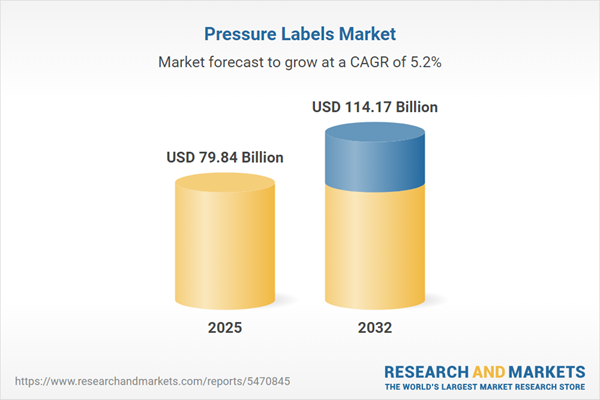Speak directly to the analyst to clarify any post sales queries you may have.
Senior executives aiming to enhance compliance, operational efficiency, and transparent supply chain management are accelerating adoption of pressure labels. The pressure labels market is adapting rapidly, with innovative pressure-sensitive solutions meeting the evolving demands of global B2B operations.
Market Snapshot: Pressure Labels Market Overview
The global pressure labels market is experiencing steady expansion, driven by increasing demand for customizable and traceable labeling solutions. As organizations seek greater flexibility and assurance in brand protection, industry focus is shifting to advanced label integration across B2B value chains. Investments in supply chain technologies are supporting business leaders as they align labeling processes with best-in-class standards. This shift facilitates risk management and strengthens collaborative networks, especially for multinational supply operations. Customization capabilities and regulatory traceability further reinforce the market’s role as a strategic enabler in complex B2B ecosystems.
Scope & Segmentation of the Pressure Labels Market
This B2B market research report delivers comprehensive insight for leaders targeting packaging optimization and compliance strategies. Decision-makers benefit from in-depth analysis of market segments and regional trends relevant to procurement, production, and go-to-market initiatives.
- Form: Linerless labels, continuous release formats, friction release types, jumbo rolls, standard rolls, large formats, and standard sheets—all designed to deliver operational versatility in varying packaging and logistics environments.
- Material: Choices such as polyester, polyethylene, polypropylene films, aluminum, steel foils, and both coated and uncoated paper ensure durability and address sustainability targets in demanding B2B applications.
- Adhesive Type: Permanent adhesives, removable, repositionable, and wash-off variants provide support for recycling, secure identification, and specialized labeling in multiple industries.
- Printing Technology: Digital inkjet, direct thermal, laser, flexographic, and thermal transfer processes meet needs for high-speed, accuracy, and customization throughout labeling workflows.
- Application Sectors: Automotive, electronics, food and beverage, logistics, pharmaceuticals, healthcare, transportation, and personal care sectors each use tailored pressure label solutions for reliable operations and ongoing regulatory compliance.
- Regional Coverage: The report evaluates opportunities and compliance dynamics in the Americas, Europe, Middle East & Africa, and Asia-Pacific. Markets such as the United States, Canada, and key Latin American countries receive focused analysis to inform localized strategy adjustments.
- Key Companies: Competitive landscape analysis features Avery Dennison Corporation, CCL Industries Inc., UPM-Kymmene Corporation, Multi-Color Corporation, Herma GmbH, Lintec Corporation, Nitto Denko Corporation, Schreiner Group GmbH & Co. KG, SATO Holdings Corporation, and Amcor plc.
Key Takeaways for Senior Leaders
- Adoption of automation and digital printing technology is creating streamlined labeling workflows, enabling businesses to react quickly to changing supply chain or market demands.
- Material selection is closely integrated with sustainability initiatives, helping organizations achieve better traceability and improved visibility into supplier practices for enhanced risk management.
- Addition of smart labeling features, including RFID, QR codes, and NFC, is elevating product verification and bolstering anti-counterfeiting defenses throughout B2B channels.
- Resilient relationships with suppliers, together with adaptive market-entry strategies, foster compliance and consistency across diverse regional regulatory environments.
- Strategic alliances and targeted sector consolidation improve process efficiency and catalyze innovation, especially within essential or rapidly evolving industries.
- IoT-enabled analytics offer an ongoing foundation for optimizing label design, ensuring that client portfolios and sector-specific needs are met as markets shift.
Tariff Impact on Supply Chain and Cost Structures
Recent United States tariffs on film and foil raw materials are compelling manufacturers to reassess supply chain strategies. Organizations are evaluating new sourcing options and renegotiating supplier contracts to mitigate risk. The adoption of advanced adhesive and hybrid substrate solutions enables firms to maintain operational continuity and fortify transparent supply chain operations. These adaptations not only secure workflow reliability but also strengthen financial resilience in a fluid regulatory environment.
Methodology & Data Sources
This research draws on executive interviews, extensive literature review, and robust quantitative modeling. Frameworks such as Porter’s Five Forces and SWOT analysis are combined with expert review to assure relevant and actionable intelligence for pressure labels market stakeholders.
Why This Report Matters for the Pressure Labels Market
- Supplies senior leaders with targeted recommendations to select pressure labels that deliver compliance and operational gains in demanding B2B settings.
- Guides investments in sustainable, high-performance labeling technologies, supporting operational efficiency and reinforcing brand confidence.
- Enables agile process adaptation by leveraging IoT and data-driven analytics for continuous product and workflow evolution.
Conclusion
Integrating advanced pressure labeling solutions positions organizations to outpace regulatory trends and strengthen sustainability commitments, driving strategic growth within the competitive B2B sector.
Additional Product Information:
- Purchase of this report includes 1 year online access with quarterly updates.
- This report can be updated on request. Please contact our Customer Experience team using the Ask a Question widget on our website.
Table of Contents
3. Executive Summary
4. Market Overview
7. Cumulative Impact of Artificial Intelligence 2025
List of Figures
Companies Mentioned
The companies profiled in this Pressure Labels market report include:- Avery Dennison Corporation
- CCL Industries Inc.
- UPM-Kymmene Corporation
- Multi-Color Corporation
- Herma GmbH
- Lintec Corporation
- Nitto Denko Corporation
- Schreiner Group GmbH & Co. KG
- SATO Holdings Corporation
- Amcor PLC
Table Information
| Report Attribute | Details |
|---|---|
| No. of Pages | 185 |
| Published | November 2025 |
| Forecast Period | 2025 - 2032 |
| Estimated Market Value ( USD | $ 79.84 Billion |
| Forecasted Market Value ( USD | $ 114.17 Billion |
| Compound Annual Growth Rate | 5.2% |
| Regions Covered | Global |
| No. of Companies Mentioned | 11 |









